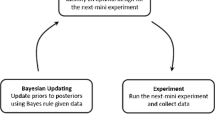Abstract
We formulate and investigate experimentally a model of how individuals choose between time sequences of monetary outcomes. The model assumes that a decision maker uses, sequentially, two criteria to screen options. Each criterion only permits a decision between some pairs of options, while the other options are incomparable according to that criterion. When the first criterion is not decisive, the decision maker resorts to the second criterion to select an alternative. We find that: (1) traditional economic models based on discounting alone cannot explain a significant (almost 30%) proportion of the data no matter how much variability in the discount functions is allowed; (2) our model, despite considering only a specific (exponential) form of discounting, can explain the data much better solely thanks to the use of the secondary criterion; (3) our model explains certain specific patterns in the choices of the “irrational” people. We reject the hypothesis that anomalous behavior is due simply to random “mistakes” around the basic predictions of discounting theories: deviations are not random and there are clear systematic patterns of association between “irrational” choices.
Similar content being viewed by others
References
Abdellaoui, M., Attema, A. E., & Bleichrodt, H. (2009). Intertemporal tradeoffs for gains and losses: An experimental measurement of discounted utility. Economic Journal (forthcoming).
Agresti, A., (2002). Categorical Data Analysis. Wiley Series in Probability and Statistics, 2nd Ed. Hoboken, NJ: Wiley.
Andersen S., Harrison G. W., Lau M. I., Rutström E. E. (2008) Eliciting risk and time preferences. Econometrica 76: 583–618
Chapman G. B. (1996) Expectations and preferences for sequences of health and money. Organizational Behavior and Human Decision Processes 67: 59–75
Coller M., Williams M. (1999) Eliciting individual discount rates. Experimental Economics 2: 107–127
Cubitt R. P., Read D. (2007) Can intertemporal choice experiments elicit time preferences for consumption? Experimental Economics 10: 369–389
Fishburn P. (1970) Utility theory for decision making. Wiley, New York
Frederick S., Loewenstein G., O’Donoghue T. (2002) Time discounting and time preferences: A critical review. Journal of Economic Literature 40: 351–401
Gigliotti G., Sopher B. (1997) Violations of present value maximization in income choice. Theory and Decision 43: 45–69
Guyse J., Keller L., Epple T. (2002) Valuing environmental outcomes: Preferences for constant or improving sequences. Organizational Behavior and Human Decision Processes 87: 253–277
Loewenstein G., Prelec D. (1991) Negative time preference. American Economic Review 81: 347–352
Loewenstein G., Prelec D. (1992) Anomalies in intertemporal choice: Evidence and interpretation. Quarterly Journal of Economics 107: 573–597
Loewenstein G., Prelec D. (1993) Preferences for sequences of outcomes. Psychological Review 100: 91–108
Loewenstein G., Sicherman N. (1991) Do workers prefer increasing wage profiles? Journal of Labour Economics 9: 67–84
Manzini P., Mariotti M. (2007) Sequentially rationalizable choice. American Economic Review 97: 1824–1839
Manzini, P., & Mariotti, M. (2006a). Two-stage boundedly rational choice procedures: Theory and experimental evidence, IZA Discussion Paper no. 2341. Bonn: IZA.
Manzini, P., & Mariotti, M. (2006b). A vague theory of choice over time. Advances in Theoretical Economics, 6(1), Article 6. http://www.bepress.com/bejte/advances/vol6/iss1/art6.
Manzini P., Mariotti M. (2009) Choice over time. In: Anand P., Pattanaik P., Puppe C. (eds) Oxford handbook of rational and social choice. Oxford University Press, Oxford
Noor J. (2009) Hyperbolic discounting and the standard model: Eliciting discount functions. Journal of Economic Theory 144: 2077–2083
Read D. (2001) Is time-discounting hyperbolic or subadditive? Journal of Risk and Uncertainty 23: 5–32
Read D., Powell M. (2002) Reasons for sequence preferences. Journal of Behavioral Decision Making 15: 433–460
Roelofsma P. H., Read D. (2000) Intransitive intertemporal choice. Journal of Behavioral Decision Making 13: 161–177
Rubinstein A. (2001) A theorist’s view of experiments. European Economic Review 45: 615–628
Rubinstein A. (2003) Is it ‘Economics and Psychology?’ The case of hyperbolic discounting. International Economic Review 44: 1207–1216
Selten R. (1991) Properties of a measure of predictive success. Mathematical Social Sciences 21: 153–167
Tversky A. (1969) Intransitivity of preferences. Psychological Review 76: 31–48
Tversky A., Sattath S., Slovic P. (1988) Contingent weighting in judgement and choice. Psychological Review 95: 371–384
Varey C., Kahneman D. (1990) Experiences extended across time: Evaluation of moments and episodes. Journal of Behavioral Decision Making 5: 169–185
Author information
Authors and Affiliations
Corresponding author
Rights and permissions
About this article
Cite this article
Manzini, P., Mariotti, M. & Mittone, L. Choosing monetary sequences: theory and experimental evidence. Theory Decis 69, 327–354 (2010). https://doi.org/10.1007/s11238-010-9214-7
Published:
Issue Date:
DOI: https://doi.org/10.1007/s11238-010-9214-7




